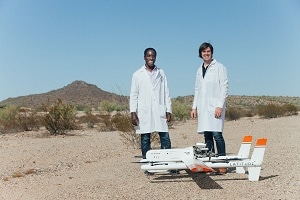Sep 13 2017
A new delivery distance record for medical drones has been set by Researchers at Johns Hopkins, who have successfully transported human blood samples across 161 miles of Arizona desert. During the three-hour flight, they explained, the on-board payload system regulated the temperature, ensuring the samples were viable for laboratory analysis after touchdown.
 Dr. Timothy Amukele and Jeff Street have set a new delivery distance record for medical drones. (Credit: Johns Hopkins Medicine)
Dr. Timothy Amukele and Jeff Street have set a new delivery distance record for medical drones. (Credit: Johns Hopkins Medicine)
In a paper published in the American Journal of Clinical Pathology on September 6th, the research team narrates that the accomplishment adds to evidence that unmanned aircraft can be used to effectively and safely transport medical samples from remote sites to laboratories in a timely manner.
“We expect that in many cases, drone transport will be the quickest, safest and most efficient option to deliver some biological samples to a laboratory from rural or urban settings,” says Timothy Amukele, M.D., Ph.D., Assistant Professor of Pathology at the Johns Hopkins University School of Medicine and the paper’s Senior Author.
Drones can operate where there are no roads, and overcome conditions that disable wheeled vehicles, traffic and other logistical inefficiencies that are the enemy of improved, timely patient diagnoses and care. Drones are likely to be the 21st century’s best medical sample delivery system.
Timothy Amukele, M.D., Ph.D., Assistant Professor of Pathology, the Johns Hopkins University School of Medicine and the Paper’s Senior Author
Adding onto earlier work by Amukele’s team, the Researchers first collected pairs of 84 blood samples at the University of Arizona in Tucson and took them to an airfield 76 miles away.
One sample from each pair was placed in a commercially available drone, which flew them 161 miles. The flight flew and landed at the same airfield, on a drone test range. The samples flown by drone were kept in a temperature-controlled chamber put together by the Johns Hopkins team. The other sample of each pair was kept in a car at the airfield with active cooling to sustain target temperature. The average temperature of the flown samples was 24.8 °C (76.6 °F) while the temperature of the samples not flown was 27.3 °C (81.1 °F).
Among other safety measures, the test was conducted away from populated areas in classified airspace at an uninhabited military test range that was cleared of other air traffic. The aircraft was controlled by a certified remote pilot, using a radio link between the ground control station and the drone’s onboard flight computer. Samples were packed and flown according to the regulations of the International Air Transport Association. A Latitude Engineering HQ-40 aircraft was used for this study.
After the flight, all samples were transported in a car to the Mayo Clinic in Scottsdale, Arizona, 62 miles away. All samples were analyzed for 17 of the 19 most common hematology and chemistry tests. Flown and not-flown paired samples exhibited similar results for white blood cell, red blood cell and platelet counts and sodium levels, among other results. Statistically noteworthy but small differences were observed in potassium and glucose levels, which also exhibited variation in standard transport techniques such as automobile transport. These variances were because of chemical degradation from marginally warmer temperature in the not-flown samples.
The Johns Hopkins team earlier studied the influence of drone transportation on the hematological, chemical and microbial characteristics of drone-flown blood samples across distances up to 20 miles, and discovered that none were negatively impacted. The team plans further and wide-ranging studies in the U.S. and overseas.
Getting diagnostic results far more quickly under difficult conditions will almost certainly improve care and save more lives.
Timothy Amukele, M.D., Ph.D., Assistant Professor of Pathology, the Johns Hopkins University School of Medicine and the Paper’s Senior Author
Other Authors on this study include Jeff Street of the Johns Hopkins University School of Medicine; Christine LH Snozek and James Hernandez of the Mayo Clinic in Arizona; and Ryan G. Wyatt, Matthew Douglas and Richard Amini of the University of Arizona.
This study received funding from Peter Kovler of the Blum-Kovler Foundation.